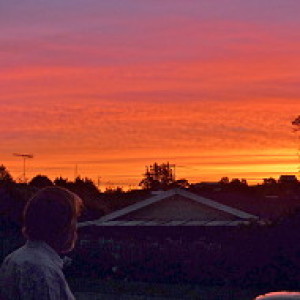Putangitangi; Paradise Shelduck
A later start this morning circling around to the next bay along, Algies Bay. It was a coldish morning and rather grey in colour. On the way, I saw a tui chasing a small sparrow out of the tree it had chosen to sing from, and then return to continue singing. It did sit at the top of the tree for a portrait. The little camera struggles at that distance.
Around in Algies, just before heading up the 400 steps to the Highfield Garden lookout (I walk most of it), I heard what sounded to me like a distress call from this female Paradise Duck (a shelduck; known by Maori as putangitangi). It did not move away as I got closer and closer, all the time taking pictures in case that was as close as I could get. The calls continued with sharp whistles as well.
There were occasional answering calls from the trees above the bay, and although not appearing to be injured (at least to me) I wonder if the duck was both warning the drake and trying to keep me from approaching the nest or the ducklings. Most weekends recently I have seen a pair at the northern end of Snells Beach. Probably a different pair.
I have cropped this so as to enlarge it a wee bit; otherwise it is as it was taken.
Below is some abridged info I found about the putangitangi.
Putangitangi, the paradise shelduck, is endemic to New Zealand, that is it is found nowhere else in the world. Although not a common bird before settlement by Europeans they have prospered with the conversion of native forest to pasture, and have increased greatly in numbers.
They are a large duck and are always seen in pairs except during the moulting season. The drake has a black head with a greenish gloss, the body being dark grey barred with black. The undertail and tertials are orange chestnut. The duck has a white head and the body is a bright orange chestnut.
Most paradise duck start breeding when 2 years old and pairs remain together from year to year, returning to the same nesting area. If one bird dies, its mate occupies the same territory and re-mates again. Usually the nest is placed on the ground well hidden beneath a log or clumps of grass, but occasionally it is built in a tree fifteen to twenty feet above the ground. The nest is made of grass and lined with down plucked from the duck's own body. When the ducklings hatch, the device of luring enemies away from the nest by feigning a broken wing is used by the parents.

Comments
Sign in or get an account to comment.


